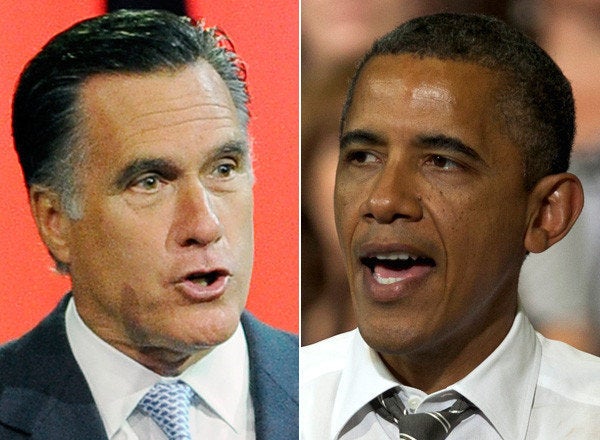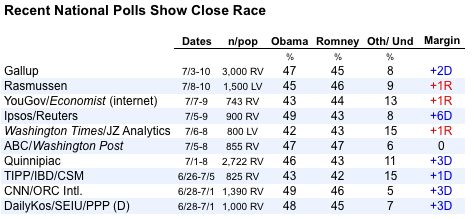
WASHINGTON -- Same as it ever was. That's the primary message from the latest batch of national polls on the race for president conducted in early July. Collectively they show the race in roughly the same place as it has been for months: very close, with most polls giving President Barack Obama a slight edge over presumptive Republican nominee Mitt Romney.
The latest survey released on Wednesday by the Quinnipiac University Polling Institute gives Obama a three percentage point lead over Romney (43 to 40 percent) nationwide. Similarly, the Wednesday release by the Gallup Daily national tracking poll shows Obama leading Romney by two points (47 to 45 percent).
The latest Quinnipiac and Gallup surveys find Obama with about the same advantage as does the HuffPost Pollster chart, which calculates trend lines based on all available public polls. As of this writing, the chart shows the president leading his challenger by just under two points (45.9 to 44.1 percent).
Obama has maintained roughly the same one- to two-point lead for most of the past year, except for a brief period in the heat of the Republican primaries in February when he led by a slightly larger margin. As the Washington Post reported on Tuesday, "a pair of tepid jobs reports, landmark Supreme Court decisions on health-care and immigration laws, and an unprecedented barrage of negative ads" in recent weeks have had virtually no impact on the national horse race numbers.
Of course, the HuffPost Pollster trend lines smooth out quite a bit of variation among individual polls. The latest surveys included in the chart represent polls completed in July by 10 different organizations. Of these, six show Obama slightly ahead, three give Romney the edge, and one finds an exact tie. Nevertheless, the margins separating the two candidates on most of these polls were too close to be statistically significant.

Variation aside, the narrow Obama advantage in the national polls translates, as expected, into a modest Electoral College advantage for the president in the individual state polls. The HuffPost Election Map combines polling results from battleground states with our expectations about less frequently polled states that have consistently favored one party or another in recent elections. It currently shows Obama leading in states whose electoral votes total 263, seven short of the 270 needed to win. Romney leads in states representing 191 electoral votes, and five states are classified as toss-ups based on current polling.
One caution regarding the national polls: Most are reporting results among all registered voters and have not yet attempted to narrow their samples to those Americans most likely to vote. Historically, polls of "likely voters" are a few points more Republican than those of all registered voters, a pattern that also appears in the latest crop of national polls.
The two pollsters that currently screen for likely voters both give Romney a narrow advantage. Moreover, other surveys have found greater engagement in and enthusiasm about the election among Republicans. So when pollsters do start narrowing to likely voters, the shift will likely boost Romney slightly.
On the other hand, the continuing decline in polling response rates may make these likely-voter screens less necessary than in past presidential elections. The lower response rates, combined with the tendency of non-voters to opt out of political surveys, mean that samples of registered voters are already skewing toward frequent and likely voters. A recent Pew Research Center study that checked actual voting records found that households that participated in surveys were more likely to have cast ballots in 2010 (55 percent) than households that did not participate (44 percent). Pollsters will need to take this factor into account or risk narrowing their samples too much in search of the likely electorate.
Either way, horse race polling on the 2012 election is likely to keep puzzling many political observers. Statistical noise is inherent in polling, so if the Obama-Romney contest remains close, polls will routinely tip a few points to one candidate or the other. Looking at the HuffPost Pollster chart, which is designed to smooth out much of that random variation, can help.
Buckle up, polling junkies, it's going to be a bumpy ride.
